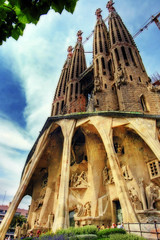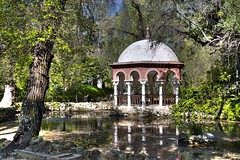The short version of our itinerary is here:
We started out in Spain, first visiting Barcelona. From there we visited Granada, then Algeciras, then took a quick ferry ride to Ceuta (technically owned by Spain, but still geographically part of Morocco ~ AFRICA!). Here's a Google Map of our route with notes for a summary (click on the place markers and icons and you'll get the Coles notes version of what follows in my post below ~ please know that rather than perseverating on the perfection of the map at all resolutions, I decided to carry on and not drive myself INSANE!!!! Can you tell that this first venture with Google Maps was a little frustrating for me?!)
My first post about our adventures is here if you're interested!
In that post, I described (besides the fact that Paul was really sick) our first day in Barcelona.
And I have so much more to share since then!
On our second day in Barcelona, we had a nice walk to see some of the famous Gaudí architecture at La Sagrada Familia. It would be an understatement to say how blown away I was.
For many reasons, I don't usually go into religious buildings when I travel (that's another blog post, though).
But this was different. Mainly because Antonio Gaudí seemed to follow an organic desire to merge nature and the senses into his architecture. And because he worked most of his life on this project - from 1883 - 1926. And because his work is inspired by the geometry of nature, human anatomy and the cosmos. Circular arcs, spirals, spheres, curves and all things seemingly structurally impossible, yet he made it happen.
The image above is of the front facade which depicts Jesus' crucifixion. Notice how the pillars look like bones? That was the inspiration. Haunting, yes. Cool factor = 100/100.
And this image below is what the interior looks like. Remind you of being in a forest, looking up at the canopy? Exactly. Gaudi hoped to recreate the serenity of nature for contemplation. He even created "scabs" on the tree trunks where, if this were a real forest, the lower branches would have needed to be cut.
(amazing photo - credit here)
Poor guy, had an unfortunate death though. It turns out Gaudi was run over by a tram. Because he looked a little rough and had no cash on him, cabbies refused to take him to the hospital (really? this was in 1926...hard to imagine!). Eventually, though, Gaudi was taken to a paupers' hospital in Barcelona. Nobody recognized the injured artist until his friends found him the next day. When they tried to move him into a nicer hospital, Gaudí refused, reportedly saying "I belong here among the poor." He died three days later on 10 June 1926, at age 73, half of Barcelona mourning his death. He was buried in the midst of La Sagrada Família.
Our Christmas day was a 13.5 hour journey from Barcelona to Granada on a train. Ok, not quite like the luxury car that Trixie and I had in October when we traveled from Sarajevo to Budapest (where we had a private car we could each lay down in), but we made it.
In Granada (the last Muslim stronghold on the Iberian Peninsula - which includes modern-day Portugal, Spain, Andorra and Gibraltar and a very small area of France), we saw the famous Alhambra. Apparently it is the most perfect example of moorish art in it's final European development. The interior is decorated with unique Arabesque designs and references Allah over and over and over again
Alhambra was place where Christopher Columbus convinced Queen Isabella that financing his cartographic voyages was a a worthy investment. Despite the fact that King Ferdinand and a host of advisers laughed at the proposal, it is said that Isabella handed him a "stack of bills" to assist with his "the-earth-is-spherical-not-flat" funding campaign.
In Granada we also stumbled upon a *free* opportunity to have our photos taken. My ears perk up at the word *free* (especially since we didn't take a camera along on this trip).
So it turns out that Zwarte Piet (who is Sinterklaas' helper - S-klaas being the Santa Claus equivalent in Holland, The Netherlands, Belgium and other places) was in Granada. Zwarte Piet (Black Piet) is Sinterklaas' helper. And he's black. But the jury (according to Wikipedia) is out as to exactly why he is black. Is it because he is of Moorish descent? Or because he is a chimney sweep helping Sinterklaas on rooftops everywhere (a rather dirty occupation)? As you can imagine ZP's colour is a controversial topic...
Why was Zwarte Piet in Granada? Apparently because legend has it that he goes there on off season to "school" to continue to "learn his trade". Think North Pole and the elves building all those toys. Same deal I guess!
Here we are with him.....my sister says he looks like Gary Coleman (?!)
We left Granada to travel to Algeciras. Although the second half of the journey to get there was a little rough (a 2 hour bus ride hugging cliffs on curves as we spiraled up a mountain), it was a great destination. Even though it's typically visited only briefly as it is a port town which gets across the sea to Morocco, it's a nice spot. It's a very walkable city and has a great daily market and many beautiful plazas/placas.
When we arrived in Algeciras, Paul had a "sick day" and then the following day we journeyed to Ceuta, Morocco by ferry. Although the original intention was to travel to Tangier, Morocco, apparently the sea swells in the Atlantic were enormous causing ferry delays and leaving folks stranded.
So instead we visited Ceuta, a short 45 minute ferry ride from Algeciras across the Straight of Gibraltar. While on the African continent, Ceuta is a city owned by Spain.
It was beautiful, and there was definitely an African vibe there. No market, but that gave us the opportunity to experience the natural beauty of the city.
There was a "Royal Wall" surrounding the entrance to the city and a moat (pictured on the right).
And get a load of this beach that gave us a chance to dip fingers and toes into the Mediterranean Sea!
This is where I packed some warm breezes and summer-like sensory experiences into my bones. That memory is helping now that I'm back in wintry Toronto!
We also had a great walk around some interesting Muslim neighbourhoods and luxuriated on vibrantly green and cushy grass under trees swish-swish-swishing in the wind.
Then back on the ferry to Algeciras.
From Algeciras we took a bus to Seville. Here, we ignored the
guidebooks recommendation to visit the 2nd biggest
cathedral in Europe, and as a result stumbled upon an amazing park.
Before finding the park, we had a look at the Plaza de España - lots of folks were taking horse and carriage rides around the inner court.
In 1929 Seville hosted the Spanish-American Exhibition and numerous buildings were constructed around the Plaza for the exhibition in Maria Luisa Park.
Peacock overseeing everything! Beautiful sculptures and monuments lined an intricate network of paths. And fresh clean air and the sound of branches and leaves being swept away by the wind.
We had a quick tour at the oldest bull fighting ring in Spain - the Plaza De Toros De Maestranza
Seville was where I had one of my best seafood meals. Tender, flaky cod in almond sauce with the greenest tastiest asparagus imaginable. Mmmmm.....
From Seville, we traveled to Lisbon. We treated ourselves to traveling in style. We took a 1 hour flight - delightful! My legs and hips thanked me after all those long train and bus rides!
Within the first 5 minutes of being off the airport transfer bus in Lisbon, Paul was asked by 2 separate people if he wanted to buy marijuana or cocaine...shortly after that we were turned away at the hostel we had reserved (due to a leaky roof) but ended up in a nice hostel nearby.
I enjoyed seeing all the beautiful black and white stone patterns in sidewalks, squares and mostly every where one looks!
It turns out that Lisbon is built on a series of 7 hills. There are 3 funiculars (one of which is a actually an elevator) which connects the lower to the higher elevations. We walked up a 265 meter incline (buns of steel!) and along the way came across Lisbon's Urban Art Show. Cool.
On Dec 31, we enjoyed visiting the Port Wine Institute where we sampled a 15 year old tawny, a 30 year old tawny and a 8 year old white port. There really is a difference - the aging seems to dull the acidity, giving it a very smooth finish.
Later that same day, we went to the oldest Beer Hall in Portugal, called the Cervejaria Trindade. It had these unbelievable tiled walls depicting the 4 seasons and the 4 elements.
By the time 8pm rolled around on New Year's Eve, Paul and I were so exhausted from all the imbibing during the day that we crashed and didn't ring in 2010 with all the revelers out in the squares.
Our flights home was pretty uneventful but LONG. Lisbon to Amsterdam to Philadelphia to Toronto. For what it's worth, the rocking chairs in the Philadelphia airport are mighty comfy and soothing!
This trip was a great conclusion to 2009 and an even better way to welcome 2010. I am so grateful for the experience! We visited 3 countries, 6 cities and took 7 flights, 2 train rides, 2 bus rides and 1 ferry ride - all in 12 days!















No comments:
Post a Comment